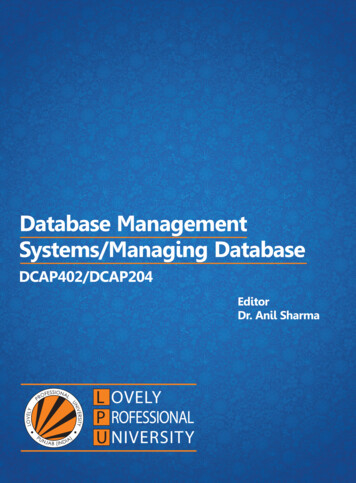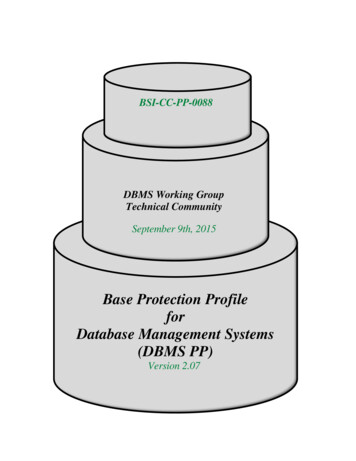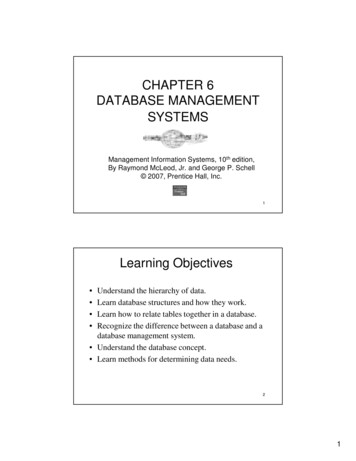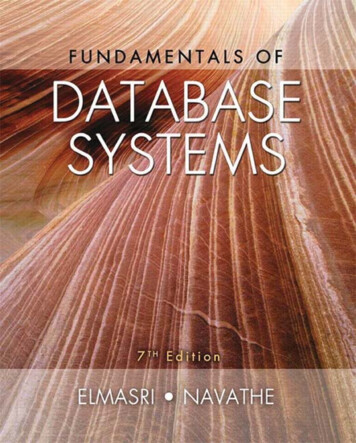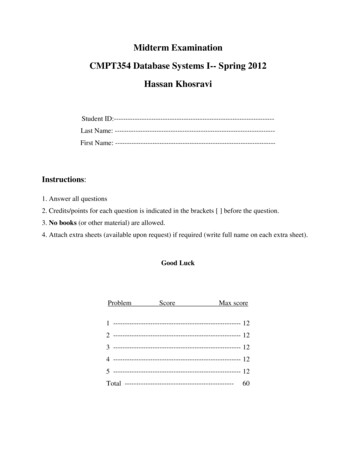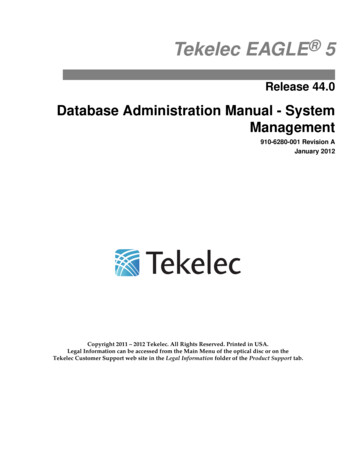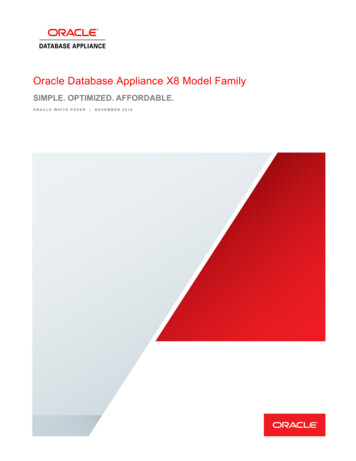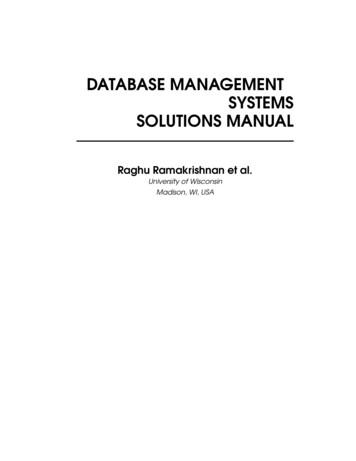
Transcription
DATABASE MANAGEMENTSYSTEMSSOLUTIONS MANUALRaghu Ramakrishnan et al.University of WisconsinMadison, WI, USA
CONTENTSPREFACEiii1INTRODUCTION TO DATABASE SYSTEMS12THE ENTITY-RELATIONSHIP MODEL53THE RELATIONAL MODEL144RELATIONAL ALGEBRA AND CALCULUS235SQL: QUERIES, PROGRAMMING, TRIGGERS406QUERY-BY-EXAMPLE (QBE)567STORING DATA: DISKS AND FILES658FILE ORGANIZATIONS AND INDEXES729TREE-STRUCTURED INDEXING7510 HASH-BASED INDEXING8711 EXTERNAL SORTING10512 EVALUATION OF RELATIONAL OPERATORS10913 INTRODUCTION TO QUERY OPTIMIZATION11814 A TYPICAL QUERY OPTIMIZER119i
iiDatabase Management Systems Solutions Manual15 SCHEMA REFINEMENT AND NORMAL FORMS13416 PHYSICAL DATABASE DESIGN AND TUNING14517 SECURITY15818 TRANSACTION MANAGEMENT OVERVIEW16319 CONCURRENCY CONTROL16820 CRASH RECOVERY18021 PARALLEL AND DISTRIBUTED DATABASES190
PREFACEIt is not every question that deserves an answer.Publius Syrus, 42 B.C.I hope that most of the questions in this book deserve an answer. The set of questionsis unusually extensive, and is designed to reinforce and deepen students’ understandingof the concepts covered in each chapter. There is a strong emphasis on quantitative andproblem-solving type exercises. Answers to almost all chapter exercises are includedin this solutions manual for Chapters 1 through 19. Solutions for Chapters 20 through22 are currently unavailable.While I wrote some of the solutions myself, most were written originally by studentsin the database classes at Wisconsin. I’d like to thank the many students who helpedin developing and checking the solutions to the exercises; this manual would not beavailable without their contributions. In alphabetical order: X. Bao, S. Biao, M.Chakrabarti, C. Chan, W. Chen, N. Cheung, D. Colwell, C. Fritz, V. Ganti, J. Gehrke,G. Glass, V. Gopalakrishnan, M. Higgins, T. Jasmin, M. Krishnaprasad, Y. Lin, C. Liu,M. Lusignan, H. Modi, S. Narayanan, D. Randolph, A. Ranganathan, J. Reminga, A.Therber, M. Thomas, Q. Wang, R. Wang, Z. Wang and J. Yuan. In addition, JamesHarrington and Martin Reames at Wisconsin and Nina Tang at Berkeley providedespecially detailed feedback.Several students contributed to each chapter’s solutions, and answers were subsequently checked by me and by other students. This manual has been in use for severalsemesters. I hope that it is now mostly accurate, but I’m sure it still contains errors and omissions. If you are a student and you do not understand a particularsolution, contact your instructor; it may be that you are missing something, but itmay also be that the solution is incorrect! If you discover a bug, please send me mail(raghu@cs.wisc.edu) and I will update the manual promptly.The latest version of this solutions manual is distributed freely through the Web; goto the home page mentioned below to obtain a copy.iii
Database Management Systems Solutions ManualFor More InformationThe home page for this book is at URL:http://www.cs.wisc.edu/ dbbookThis page is frequently updated and contains information about the book, past andcurrent users, and the software. This page also contains a link to all known errors inthe book, the accompanying slides, and the software. Since the solutions manual isdistributed electronically, all known errors are immediately fixed and no list of errors ismaintained. Instructors are advised to visit this site periodically; they can also registerat this site to be notified of important changes by email.
1INTRODUCTION TODATABASE SYSTEMSExercise 1.1 Why would you choose a database system instead of simply storing datain operating system files? When would it make sense not to use a database system?Answer 1.1 A database is an integrated collection of data, usually so large that ithas to be stored on secondary storage devices such as disks or tapes. This data canbe maintained as a collection of operating system files, or stored in a DBMS (databasemanagement system). The advantages of using a DBMS are:Data independence and efficient access. Database application programs are independent of the details of data representation and storage. The conceptual andexternal schemas provide independence from physical storage decisions and logicaldesign decisions respectively. In addition, a DBMS provides efficient storage andretrieval mechanisms, including support for very large files, index structures andquery optimization.Reduced application development time. Since the DBMS provides several important functions required by applications, such as concurrency control and crashrecovery, high level query facilities, etc., only application-specific code needs tobe written. Even this is facilitated by suites of application development toolsavailable from vendors for many database management systems.Data integrity and security. The view mechanism and the authorization facilitiesof a DBMS provide a powerful access control mechanism. Further, updates to thedata that violate the semantics of the data can be detected and rejected by theDBMS if users specify the appropriate integrity constraints.Data administration. By providing a common umbrella for a large collection ofdata that is shared by several users, a DBMS facilitates maintenance and dataadministration tasks. A good DBA can effectively shield end-users from the choresof fine-tuning the data representation, periodic back-ups etc.1
2Chapter 1Concurrent access and crash recovery. A DBMS supports the notion of a transaction, which is conceptually a single user’s sequential program. Users can writetransactions as if their programs were running in isolation against the database.The DBMS executes the actions of transactions in an interleaved fashion to obtaingood performance, but schedules them in such a way as to ensure that conflictingoperations are not permitted to proceed concurrently. Further, the DBMS maintains a continuous log of the changes to the data, and if there is a system crash,it can restore the database to a transaction-consistent state. That is, the actionsof incomplete transactions are undone, so that the database state reflects only theactions of completed transactions. Thus, if each complete transaction, executingalone, maintains the consistency criteria, then the database state after recoveryfrom a crash is consistent.If these advantages are not important for the application at hand, using a collection offiles may be a better solution because of the increased cost and overhead of purchasingand maintaining a DBMS.Exercise 1.2 What is logical data independence and why is it important?Answer 1.2 Answer omitted.Exercise 1.3 Explain the difference between logical and physical data independence.Answer 1.3 Logical data independence means that users are shielded from changesin the logical structure of the data, while physical data independence insulates usersfrom changes in the physical storage of the data. We saw an example of logical dataindependence in the answer to Exercise 1.2. Consider the Students relation from thatexample (and now assume that it is not replaced by the two smaller relations). Wecould choose to store Students tuples in a heap file, with a clustered index on thesname field. Alternatively, we could choose to store it with an index on the gpa field,or to create indexes on both fields, or to store it as a file sorted by gpa. These storagealternatives are not visible to users, except in terms of improved performance, sincethey simply see a relation as a set of tuples. This is what is meant by physical dataindependence.Exercise 1.4 Explain the difference between external, internal, and conceptual schemas. How are these different schema layers related to the concepts of logical andphysical data independence?Answer 1.4 Answer omitted.Exercise 1.5 What are the responsibilities of a DBA? If we assume that the DBAis never interested in running his or her own queries, does the DBA still need tounderstand query optimization? Why?
Introduction to Database Systems3Answer 1.5 The DBA is responsible for:Designing the logical and physical schemas, as well as widely-used portions of theexternal schema.Security and authorization.Data availability and recovery from failures.Database tuning: The DBA is responsible for evolving the database, in particularthe conceptual and physical schemas, to ensure adequate performance as userrequirements change.A DBA needs to understand query optimization even if s/he is not interested in running his or her own queries because some of these responsibilities (database designand tuning) are related to query optimization. Unless the DBA understands the performance needs of widely used queries, and how the DBMS will optimize and executethese queries, good design and tuning decisions cannot be made.Exercise 1.6 Scrooge McNugget wants to store information (names, addresses, descriptions of embarrassing moments, etc.) about the many ducks on his payroll. Notsurprisingly, the volume of data compels him to buy a database system. To savemoney, he wants to buy one with the fewest possible features, and he plans to run it asa stand-alone application on his PC clone. Of course, Scrooge does not plan to sharehis list with anyone. Indicate which of the following DBMS features Scrooge shouldpay for; in each case also indicate why Scrooge should (or should not) pay for thatfeature in the system he buys.1. A security facility.2. Concurrency control.3. Crash recovery.4. A view mechanism.5. A query language.Answer 1.6 Answer omitted.Exercise 1.7 Which of the following plays an important role in representing information about the real world in a database? Explain briefly.1. The data definition language.
4Chapter 12. The data manipulation language.3. The buffer manager.4. The data model.Answer 1.7 Let us discuss the choices in turn.The data definition language is important in representing information because itis used to describe external and logical schemas.The data manipulation language is used to access and update data; it is notimportant for representing the data. (Of course, the data manipulation languagemust be aware of how data is represented, and reflects this in the constructs thatit supports.)The buffer manager is not very important.The data model is fundamental to representing information. The data modeldetermines what data representation mechanisms are supported by the DBMS.The data definition language is just the specific set of language constructs availableto describe an actual application’s data in terms of the data model.Exercise 1.8 Describe the structure of a DBMS. If your operating system is upgradedto support some new functions on OS files (e.g., the ability to force some sequence ofbytes to disk), which layer(s) of the DBMS would you have to rewrite in order to takeadvantage of these new functions?Answer 1.8 Answer omitted.Exercise 1.9 Answer the following questions:1. What is a transaction?2. Why does a DBMS interleave the actions of different transactions, instead ofexecuting transactions one after the other?3. What must a user guarantee with respect to a transaction and database consistency? What should a DBMS guarantee with respect to concurrent execution ofseveral transactions and database consistency?4. Explain the strict two-phase locking protocol.5. What is the WAL property, and why is it important?
2THE ENTITY-RELATIONSHIP MODELExercise 2.1 Explain the following terms briefly: attribute, domain, entity, relationship, entity set, relationship set, one-to-many relationship, many-to-many relationship,participation constraint, overlap constraint, covering constraint, weak entity set, aggregation, and role indicator.Answer 2.1 No answer provided yet.Exercise 2.2 A university database contains information about professors (identifiedby social security number, or SSN) and courses (identified by courseid). Professorsteach courses; each of the following situations concerns the Teaches relationship set.For each situation, draw an ER diagram that describes it (assuming that no furtherconstraints hold).1. Professors can teach the same course in several semesters, and each offering mustbe recorded.2. Professors can teach the same course in several semesters, and only the mostrecent such offering needs to be recorded. (Assume this condition applies in allsubsequent questions.)3. Every professor must teach some course.4. Every professor teaches exactly one course (no more, no less).5. Every professor teaches exactly one course (no more, no less), and every coursemust be taught by some professor.6. Now suppose that certain courses can be taught by a team of professors jointly,but it is possible that no one professor in a team can teach the course. Model thissituation, introducing additional entity sets and relationship sets if necessary.Answer 2.2 Answer omitted.5
6Chapter 2Exercise 2.3 Consider the following information about a university database:Professors have an SSN, a name, an age, a rank, and a research specialty.Projects have a project number, a sponsor name (e.g., NSF), a starting date, anending date, and a budget.Graduate students have an SSN, a name, an age, and a degree program (e.g., M.S.or Ph.D.).Each project is managed by one professor (known as the project’s principal investigator).Each project is worked on by one or more professors (known as the project’sco-investigators).Professors can manage and/or work on multiple projects.Each project is worked on by one or more graduate students (known as theproject’s research assistants).When graduate students work on a project, a professor must supervise their workon the project. Graduate students can work on multiple projects, in which casethey will have a (potentially different) supervisor for each one.Departments have a department number, a department name, and a main office.Departments have a professor (known as the chairman) who runs the department.Professors work in one or more departments, and for each department that theywork in, a time percentage is associated with their job.Graduate students have one major department in which they are working on theirdegree.Each graduate student has another, more senior graduate student (known as astudent advisor) who advises him or her on what courses to take.Design and draw an ER diagram that captures the information about the university.Use only the basic ER model here, that is, entities, relationships, and attributes. Besure to indicate any key and participation constraints.Answer 2.3 The ER diagram is shown in Figure 2.1.Exercise 2.4 A company database needs to store information about employees (identified by ssn, with salary and phone as attributes); departments (identified by dno,with dname and budget as attributes); and children of employees (with name and ageas attributes). Employees work in departments; each department is managed by an
specialitypidThe Entity-Relationship Modelagestart datework inssnranksponsorend dateFigure 2.1budgetManagesProfessorER Diagram for Exercise 2.3Work deptprojectSupervisesRunsssnWork projpc essndnameagedeg prog7
8Chapter 2employee; a child must be identified uniquely by name when the parent (who is anemployee; assume that only one parent works for the company) is known. We are notinterested in information about a child once the parent leaves the company.Draw an ER diagram that captures this information.Answer 2.4 Answer omitted.Exercise 2.5 Notown Records has decided to store information about musicians whoperform on its albums (as well as other company data) in a database. The companyhas wisely chosen to hire you as a database designer (at your usual consulting fee of 2,500/day).Each musician that records at Notown has an SSN, a name, an address, anda phone number. Poorly paid musicians often share the same address, and noaddress has more than one phone.Each instrument that is used in songs recorded at Notown has a name (e.g., guitar,synthesizer, flute) and a musical key (e.g., C, B-flat, E-flat).Each album that is recorded on the Notown label has a title, a copyright date, aformat (e.g., CD or MC), and an album identifier.Each song recorded at Notown has a title and an author.Each musician may play several instruments, and a given instrument may beplayed by several musicians.Each album has a number of songs on it, but no song may appear on more thanone album.Each song is performed by one or more musicians, and a musician may perform anumber of songs.Each album has exactly one musician who acts as its producer. A musician mayproduce several albums, of course.Design a conceptual schema for Notown and draw an ER diagram for your schema. Thefollowing information describes the situation that the Notown database must model.Be sure to indicate all key and cardinality constraints and any assumptions that youmake. Identify any constraints that you are unable to capture in the ER diagram andbriefly explain why you could not express them.Answer 2.5 The ER diagram is shown in Figure 2.2.
ssninstrIdnameFigure 2.2ER Diagram for Exercise mIdentifierTelephonePlaceHomephone noaddresssuthorspeedtitleThe Entity-Relationship Model9
10Chapter 2Exercise 2.6 Computer Sciences Department frequent fliers have been complainingto Dane County Airport officials about the poor organization at the airport. As aresult, the officials have decided that all information related to the airport should beorganized using a DBMS, and you’ve been hired to design the database. Your first taskis to organize the information about all the airplanes that are stationed and maintainedat the airport. The relevant information is as follows:Every airplane has a registration number, and each airplane is of a specific model.The airport accommodates a number of airplane models, and each model is identified by a model number (e.g., DC-10) and has a capacity and a weight.A number of technicians work at the airport. You need to store the name, SSN,address, phone number, and salary of each technician.Each technician is an expert on one or more plane model(s), and his or her expertise may overlap with that of other technicians. This information about techniciansmust also be recorded.Traffic controllers must have an annual medical examination. For each trafficcontroller, you must store the date of the most recent exam.All airport employees (including technicians) belong to a union. You must storethe union membership number of each employee. You can assume that eachemployee is uniquely identified by the social security number.The airport has a number of tests that are used periodically to ensure that airplanes are still airworthy. Each test has a Federal Aviation Administration (FAA)test number, a name, and a maximum possible score.The FAA requires the airport to keep track of each time that a given airplaneis tested by a given technician using a given test. For each testing event, theinformation needed is the date, the number of hours the technician spent doingthe test, and the score that the airplane received on the test.1. Draw an ER diagram for the airport database. Be sure to indicate the variousattributes of each entity and relationship set; also specify the key and participationconstraints for each relationship set. Specify any necessary overlap and coveringconstraints as well (in English).2. The FAA passes a regulation that tests on a plane must be conducted by a technician who is an expert on that model. How would you express this constraint inthe ER diagram? If you cannot express it, explain briefly.Answer 2.6 Answer omitted.
The Entity-Relationship Model11Exercise 2.7 The Prescriptions-R-X chain of pharmacies has offered to give you afree lifetime supply of medicines if you design its database. Given the rising cost ofhealth care, you agree. Here’s the information that you gather:Patients are identified by an SSN, and their names, addresses, and ages must berecorded.Doctors are identified by an SSN. For each doctor, the name, specialty, and yearsof experience must be recorded.Each pharmaceutical company is identified by name and has a phone number.For each drug, the trade name and formula must be recorded. Each drug issold by a given pharmaceutical company, and the trade name identifies a druguniquely from among the products of that company. If a pharmaceutical companyis deleted, you need not keep track of its products any longer.Each pharmacy has a name, address, and phone number.Every patient has a primary physician. Every doctor has at least one patient.Each pharmacy sells several drugs and has a price for each. A drug could be soldat several pharmacies, and the price could vary from one pharmacy to another.Doctors prescribe drugs for patients. A doctor could prescribe one or more drugsfor several patients, and a patient could obtain prescriptions from several doctors.Each prescription has a date and a quantity associated with it. You can assumethat if a doctor prescribes the same drug for the same patient more than once,only the last such prescription needs to be stored.Pharmaceutical companies have long-term contracts with pharmacies. A pharmaceutical company can contract with several pharmacies, and a pharmacy cancontract with several pharmaceutical companies. For each contract, you have tostore a start date, an end date, and the text of the contract.Pharmacies appoint a supervisor for each contract. There must always be a supervisor for each contract, but the contract supervisor can change over the lifetimeof the contract.1. Draw an ER diagram that captures the above information. Identify any constraints that are not captured by the ER diagram.2. How would your design change if each drug must be sold at a fixed price by allpharmacies?3. How would your design change if the design requirements change as follows: If adoctor prescribes the same drug for the same patient more than once, several suchprescriptions may have to be stored.
12Chapter 2ageaddressnamessnspecialityphy ssnnamePri hone numquentitytrade namePharmacySellDrugformulastart dateend datepriceMakeContractPharm cotextsupervisornameFigure 2.3phone numER Diagram for Exercise 2.8exp years
The Entity-Relationship ModelAnswer 2.7131. The ER diagram is shown in Figure 2.3.2. If the drug is to be sold at a fixed price we can add the price attribute to the Drugentity set and eliminate the Sell relationship set.3. The date information can no longer be modeled as an attribute of Prescription.We have to create a new entity set called Prescription date and make Prescriptiona 4-way relationship set that involves this additional entity set.Exercise 2.8 Although you always wanted to be an artist, you ended up being anexpert on databases because you love to cook data and you somehow confused ‘database’ with ‘data baste.’ Your old love is still there, however, so you set up a databasecompany, ArtBase, that builds a product for art galleries. The core of this productis a database with a schema that captures all the information that galleries need tomaintain. Galleries keep information about artists, their names (which are unique),birthplaces, age, and style of art. For each piece of artwork, the artist, the year it wasmade, its unique title, its type of art (e.g., painting, lithograph, sculpture, photograph),and its price must be stored. Pieces of artwork are also classified into groups of variouskinds, for example, portraits, still lifes, works by Picasso, or works of the 19th century;a given piece may belong to more than one group. Each group is identified by a name(like those above) that describes the group. Finally, galleries keep information aboutcustomers. For each customer, galleries keep their unique name, address, total amountof dollars they have spent in the gallery (very important!), and the artists and groupsof art that each customer tends to like.Draw the ER diagram for the database.Answer 2.8 Answer omitted.
3THE RELATIONAL MODELExercise 3.1 Define the following terms: relation schema, relational database schema,domain, relation instance, relation cardinality, and relation degree.Answer 3.1 A relation schema can be thought of as the basic information describinga table or relation. This includes a set of column names, the data types associatedwith each column, and the name associated with the entire table. For example, arelation schema for the relation called Students could be expressed using the followingrepresentation:Students(sid: string, name: string, login: string,age: integer, gpa: real)There are five fields or columns, with names and types as shown above.A relational database schema is a collection of relation schemas, describing one or morerelations.Domain is synonymous with data type. Attributes can be thought of as columns in atable. Therefore, an attribute domain refers to the data type associated with a column.A relation instance is a set of tuples (also known as rows or records) that each conformto the schema of the relation.The relation cardinality is the number of tuples in the relation.The relation degree is the number of fields (or columns) in the relation.Exercise 3.2 How many distinct tuples are in a relation instance with cardinality 22?Answer 3.2 Answer omitted.14
15The Relational ModelExercise 3.3 Does the relational model, as seen by an SQL query writer, providephysical and logical data independence? Explain.Answer 3.3 The user of SQL has no idea how the data is physically represented in themachine. He or she relies entirely on the relation abstraction for querying. Physicaldata independence is therefore assured. Since a user can define views, logical dataindependence can also be achieved by using view definitions to hide changes in theconceptual schema.Exercise 3.4 What is the difference between a candidate key and the primary key fora given relation? What is a superkey?Answer 3.4 Answer omitted.FIELDS (ATTRIBUTES, COLUMNS)Field namessidnameloginagegpa50000 Davedave@cs193.353666 Jonesjones@cs183.4TUPLES53688 Smithsmith@ee183.2(RECORDS, ROWS)53650 Smithsmith@math193.853831 Madayan madayan@music111.853832 Guldu122.0Figure 3.1guldu@musicAn Instance S1 of the Students RelationExercise 3.5 Consider the instance of the Students relation shown in Figure 3.1.1. Give an example of an attribute (or set of attributes) that you can deduce is nota candidate key, based on this instance being legal.2. Is there any example of an attribute (or set of attributes) that you can deduce isa candidate key, based on this instance being legal?Answer 3.5 Examples of non-candidate keys include the following: {name}, {age}.(Note that {gpa} can not be declared a non-candidate key from this evidence alone(even though common sense tells us that clearly more than one student could have thesame grade point average.)You cannot determine a key of a relation given only one instance of the relation. Thefact that the instance is “legal” is immaterial. A candidate key, as defined here, is a
16Chapter 3key, not something that only might be a key. The instance shown is just one possible“snapshot” of the relation. At other times, the same relation may have an instance (orsnapshot) that contains a totally different set of tuples, and we cannot make predictionsabout those instances based only upon the instance that we are given.Exercise 3.6 What is a foreign key constraint? Why are such constraints important?What is referential integrity?Answer 3.6 Answer omitted.Exercise 3.7 Consider the relations Students, Faculty, Courses, Rooms, Enrolled,Teaches, and Meets In that were defined in Section 1.5.2.1. List all the foreign key constraints among these relations.2. Give an example of a (plausible) constraint involving one or more of these relationsthat is not a primary key or foreign key constraint.Answer 3.7 There is no reason for a foreign key constraint (FKC) on the Students,Faculty, Courses, or Rooms relations. These are the most basic relations and must befree-standing. Special care must be given to entering data into these base relations.In the Enrolled relation, sid and cid should both have FKCs placed on them. (Realstudents must be enrolled in real courses.) Also, since real teachers must teach realcourses, both the f id and the cid fields in the Teaches relation should have FKCs.Finally, Meets In should place FKCs on both the cid and rno fields.It would probably be wise to enforce a few other constraints on this DBMS: the lengthof sid, cid, and f id could be standardized; checksums could be added to these identification numbers; limits could be placed on the size of the numbers entered into thecredits, capacity, and salary fields; an enumerated type should be assigned to the gradefield (preventing a student from receiving a grade of G, among other things); etc.Exercise 3.8 Answer each of the following questions briefly. The questions are basedon the following relational schema:Emp(eid: integer, ename: string, age: integer, salary: real)Works(eid: integer, did: integer, pct time: integer)Dept(did: integer, dname: string, budget: real, managerid: integer)1. Give an example of a foreign key constraint that involves the Dept relation. Whatare the options for enforcing this constraint when a user attempts to delete a Depttuple?
17The Relational Model2. Write the SQL statements required to create the above relations, including appropriate versions of all primary and foreign key integrity constraints.3. Define the Dept relation in SQL so that every department is guaranteed to havea manager.4. Write an SQL statement to add ‘John Doe’ as an employee with eid 101,age 32 and salary 15, 000.5. Write an SQL statement to give every employee a 10% raise.6. Write an SQL statement to delete the ‘Toy’ department. Given the referentialintegrity constraints you chose for this schema, explain what happens when thisstatement is executed.Answer 3.8 Answer omitted.
contents preface iii 1 introduction to database systems 1 2 the entity-relationship model 5 3 the relational model 14 4 relational algebra and calculus 23 5 sql: queries, programming, triggers 40 6 query-by-example (qbe) 56 7 storing data: disks and files 65 8 file organizations and indexes 72 9 tree-structured indexing 75 10 hash-based indexing 87 11 external sorting 105
